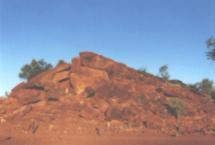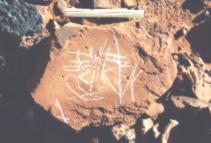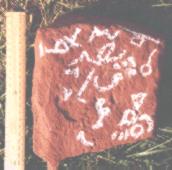Pyramids In The Pacific

The Unwritten History Of Australia
Chapter 6
|
Ophir and Sinim Australia
in Old and New Testament Literature
|
"Behold these shall come from far
and lo these from the north and the west
and these from the land of Sinim"
Isiah Chapter 49.: verse 12.
|
Chapter
6 Images
|

|
Pyramid Mound Found
by Rex Gilroy
As I have already argued in Chapters 2 and 3, the spread of the Uruan megalithic culture to the Old World, not only laid the foundation of western civilisation, but with it introduced the earliest religion, in the form of the Earth Mother/Father/Sun-God cult. With these beliefs came the traditions of a "lost paradise", the land of Uru where the first men and women lived in state of bliss, until natural catastrophes forced many to leave, to eventually arrive in Mesopotamia.
The later, Sumerian civilisation, which I argue, grew from these proto-Ayran people, carried on much of the religious mythology of the earlier megalithic age, preserving those traditions which, once borrowed by the Hebrews, would become the foundation of the Genesis Creation beliefs, and with them the preservation of dim race-memories of the original 'lost paradise' in the form of the "Garden of Eden".
The creation mythology of the first {megalithic} religion, would in course of time, develop variations, but that of the megalithic builders was basically as related in Chapter 2, namely that, the first modern humans {the Solo people} gradually became aware of the movements of of the Sun, Moon and other heavenly bodies as well as seasonal climatic changes and this led to a primitive nature-worship.
The Solo people and the Aborigines would have observed how quickly plants grew after rainfall, and in thier simplicity they imagined the earth as a female, the great Earth-Mother; frequently fertilised by the rain {ie semen} of a great Sky-Father, to seasonally give birth to all plant, animal and human life. Aware of the importance of sunlight in the cycle of life, the worshippers came to believe that the Earth-Mother and Sky-Father had produced a child, the Sun-God, depicted as a serpent in all ancient cultures.
The Earth-Mother bore her son in a cave in the east, from which he rose up every morning to cross the heavens and 'die' in the west each evening, only to "rise from the dead" in the east each morning.
These three deities survive today as the Virgin Mary {of catholic religion}, Jesus Christ {the Sun-God} and 'God' {the Sky-Father}Phallic {sex} worship was part of these beliefs as evidenced by the phallic standing stones at megalithic arrangement sites stretching from Australia to Europe. The symbolism survives today in the domes of mosques and the spires and windows of the Christian churches, with symbolic 'semen' {Holy water} and various ceremonies 'borrowed' from pagan times. In the Adam and Eve and the serpent-first people myth we see yet again the earth-Mother/Sky-Father and their child, the Sun-God depicted as a serpent.
Although the Biblical "Great Flood" had its origins in the form of a flood that covered a wide area of Mesopotamia at least several thousand years ago, those of other ancient peoples worldwide, are race-memories of the closing stages of the last great ice-age, which saw the water from the melting ice-sheets caused the oceans to rise, permanently flooding low-lying landmasses, turning land bridges that once joined continents into island chains.
Our Aboriginal people preserve the oldest myths of these tumultuous events. In one myth a great bullfrog called Tidalik drank up all the water of the world and all animal, human and plant life began to die of thirst. Everyone tried to make Tidalik open his mouth and release the water, but to no avail. Finally, the Curlu performed a very funny dance in front of him which made Tidalik laugh, allowing all the water to escape, flooding the earth, and drowning al animals, plants and aborigines. However, one warrior and his lubra escaped the flood in a canoe, taking with them plants and animals, so that when the waters subsided they were able to re-populate the landscape.
|
Pyramids
in the Pacific Images Ch 6
|

|

|

|
|
Phoenician Inscription |
Phoenician Inscription |
Phoenician Inscription |